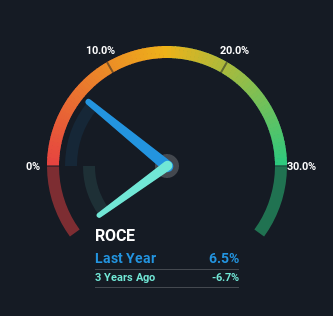- Saudi Arabia
- /
- Paper and Forestry Products
- /
- SASE:2300
Investors Will Want Saudi Paper Manufacturing's (TADAWUL:2300) Growth In ROCE To Persist

If you're not sure where to start when looking for the next multi-bagger, there are a few key trends you should keep an eye out for. One common approach is to try and find a company with returns on capital employed (ROCE) that are increasing, in conjunction with a growing amount of capital employed. Ultimately, this demonstrates that it's a business that is reinvesting profits at increasing rates of return. Speaking of which, we noticed some great changes in Saudi Paper Manufacturing's (TADAWUL:2300) returns on capital, so let's have a look.
Understanding Return On Capital Employed (ROCE)
Just to clarify if you're unsure, ROCE is a metric for evaluating how much pre-tax income (in percentage terms) a company earns on the capital invested in its business. To calculate this metric for Saudi Paper Manufacturing, this is the formula:
Return on Capital Employed = Earnings Before Interest and Tax (EBIT) ÷ (Total Assets - Current Liabilities)
0.065 = ر.س38m ÷ (ر.س978m - ر.س403m) (Based on the trailing twelve months to December 2021).
So, Saudi Paper Manufacturing has an ROCE of 6.5%. In absolute terms, that's a low return and it also under-performs the Forestry industry average of 8.3%.
See our latest analysis for Saudi Paper Manufacturing

While the past is not representative of the future, it can be helpful to know how a company has performed historically, which is why we have this chart above. If you want to delve into the historical earnings, revenue and cash flow of Saudi Paper Manufacturing, check out these free graphs here.
What Can We Tell From Saudi Paper Manufacturing's ROCE Trend?
Like most people, we're pleased that Saudi Paper Manufacturing is now generating some pretax earnings. The company was generating losses five years ago, but now it's turned around, earning 6.5% which is no doubt a relief for some early shareholders. Additionally, the business is utilizing 32% less capital than it was five years ago, and taken at face value, that can mean the company needs less funds at work to get a return. The reduction could indicate that the company is selling some assets, and considering returns are up, they appear to be selling the right ones.
Another thing to note, Saudi Paper Manufacturing has a high ratio of current liabilities to total assets of 41%. This can bring about some risks because the company is basically operating with a rather large reliance on its suppliers or other sorts of short-term creditors. While it's not necessarily a bad thing, it can be beneficial if this ratio is lower.
The Key Takeaway
From what we've seen above, Saudi Paper Manufacturing has managed to increase it's returns on capital all the while reducing it's capital base. Since the stock has returned a solid 97% to shareholders over the last five years, it's fair to say investors are beginning to recognize these changes. Therefore, we think it would be worth your time to check if these trends are going to continue.
One more thing to note, we've identified 1 warning sign with Saudi Paper Manufacturing and understanding it should be part of your investment process.
While Saudi Paper Manufacturing may not currently earn the highest returns, we've compiled a list of companies that currently earn more than 25% return on equity. Check out this free list here.
New: Manage All Your Stock Portfolios in One Place
We've created the ultimate portfolio companion for stock investors, and it's free.
• Connect an unlimited number of Portfolios and see your total in one currency
• Be alerted to new Warning Signs or Risks via email or mobile
• Track the Fair Value of your stocks
Have feedback on this article? Concerned about the content? Get in touch with us directly. Alternatively, email editorial-team (at) simplywallst.com.
This article by Simply Wall St is general in nature. We provide commentary based on historical data and analyst forecasts only using an unbiased methodology and our articles are not intended to be financial advice. It does not constitute a recommendation to buy or sell any stock, and does not take account of your objectives, or your financial situation. We aim to bring you long-term focused analysis driven by fundamental data. Note that our analysis may not factor in the latest price-sensitive company announcements or qualitative material. Simply Wall St has no position in any stocks mentioned.
About SASE:2300
Saudi Paper Manufacturing
Engages in the manufacture and sale of tissue papers in the Kingdom of Saudi Arabia, Gulf Cooperation Council countries, and internationally.
Outstanding track record with adequate balance sheet.
Market Insights
Community Narratives




